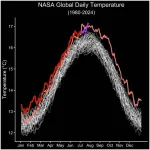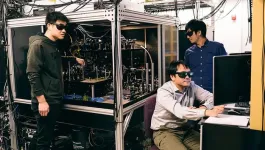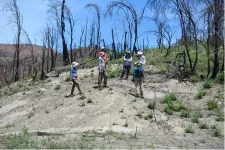(Press-News.org) July 22, 2024, was the hottest day on record, according to a NASA analysis of global daily temperature data. July 21 and 23 of this year also exceeded the previous daily record, set in July 2023. These record-breaking temperatures are part of a long-term warming trend driven by human activities, primarily the emission of greenhouse gases. As part of its mission to expand our understanding of Earth, NASA collects critical long-term observations of our changing planet.
“In a year that has been the hottest on record to date, these past two weeks have been particularly brutal,” said NASA Administrator Bill Nelson. “Through our over two dozen Earth-observing satellites and over 60 years of data, NASA is providing critical analyses of how our planet is changing and how local communities can prepare, adapt, and stay safe. We are proud to be part of the Biden-Harris Administration efforts to protect communities from extreme heat.”
This preliminary finding comes from data analyses from Modern-Era Retrospective analysis for Research and Applications, Version 2 (MERRA-2) and Goddard Earth Observing System Forward Processing (GEOS-FP) systems, which combine millions of global observations from instruments on land, sea, air, and satellites using atmospheric models. GEOS-FP provides rapid, near-real time weather data, while the MERRA-2 climate reanalysis takes longer but ensures the use of best quality observations. These models are run by the Global Modeling and Assimilation Office (GMAO) at NASA’s Goddard Space Flight Center in Greenbelt, Maryland.
Daily global average temperature values from MERRA-2 for the years 1980-2022 are shown in white, values for the year 2023 are shown in pink, and values from 2024 through June are shown in red. Daily global temperature values from July 1 to 23, 2024, from GEOS-FP are shown in purple. The results agree with an independent analysis from the European Union’s Copernicus Earth Observation Programme. While the analyses have small differences, they show broad agreement in the change in temperature over time and hottest days.
The latest daily temperature records follow 13 months of consecutive monthly temperature records, according to scientists from NASA’s Goddard Institute for Space Studies in New York. Their analysis was based on the GISTEMP record, which uses surface instrumental data alone and provides a longer-term view of changes in global temperatures at monthly and annual resolutions going back to the late 19th century.
END
NASA data shows July 22 was Earth’s hottest day on record
2024-07-29
ELSE PRESS RELEASES FROM THIS DATE:
Prestigious NIH award will advance brain research at UCR
2024-07-29
RIVERSIDE, Calif. -- A National Institutes of Health grant received by Vijayalakshmi (Viji) Santhakumar, a professor of molecular, cell and systems biology at the University of California, Riverside, has been selected for the prestigious Javits Neuroscience Investigator Award, the first time for the campus.
The five-year, $3.5 million grant from the National Institute of Neurological Disorders and Stroke, or NINDS, of the National Institutes of Health is a collaborative study with Edward Zagha, an associate professor of psychology at UCR. The award will support research into how brain circuits contribute to episodic memory formation and how ...
Purdue researchers trap atoms, forcing them to serve as photonic transistors
2024-07-29
Researchers at Purdue University have trapped alkali atoms (cesium) on an integrated photonic circuit, which behaves like a transistor for photons (the smallest energy unit of light) similar to electronic transistors. These trapped atoms demonstrate the potential to build a quantum network based on cold-atom integrated nanophotonic circuits. The team, led by Chen-Lung Hung, associate professor of physics and astronomy at the Purdue University College of Science, published their discovery in the American Physical Society’s Physical Review X.
“We developed a technique to use lasers ...
Analogies for modeling belief dynamics
2024-07-29
Researchers who study belief dynamics often use analogies to understand and model the complex cognitive–social systems that underly why we believe the things we do and how those beliefs can change over time. Ideas can be transmitted like a virus, for instance, “infecting” a population as they spread from person to person. We might be drawn — like magnets — to others with a similar worldview. A society’s beliefs can shift slowly before reaching a tipping point that thrusts society into a new phase.
In a new paper in Trends in Cognitive Sciences, SFI Professor Mirta Galesic and ...
Many juvenile ‘lifers’ freed
2024-07-29
In 1953, 15-year-old Joe Ligon and four other Pennsylvania teens went on an alcohol-fueled tear that resulted in the stabbing deaths of two people and injuries to six more.
The teens were tried as a group, and all received life without parole.
After a series of U.S. Supreme Court decisions in 2012 and 2016 found that mandatory life sentences for juveniles was unconstitutional, Ligon’s case went to federal court. After 67 long years in prison, the case was decided in his favor in 2020.
Ligon was granted his freedom in 2021 — at 83 years of age and after ...
UW model shows cortical implants like Elon Musk’s Blindsight unlikely to ‘exceed normal human vision’
2024-07-29
Elon Musk recently declared on X that Blindsight, a cortical implant to restore vision, would have low resolution at first “but may ultimately exceed normal human vision.”
That pronouncement is unrealistic at best, according to new research from the University of Washington.
Ione Fine, lead author and UW professor of psychology, said Musk’s projection for the latest Neuralink project rests on the flawed premise that implanting millions of tiny electrodes into the visual cortex, the region of the brain that processes information received from the eye, will result in high-resolution vision.
For the study, ...
UVA's Data Justice Academy receives new funding from NSF
2024-07-29
The National Science Foundation will provide funding to the University of Virginia’s Data Justice Academy, the agency recently announced, support that will help the summer program continue to serve undergraduate students from groups that are historically underrepresented in data science.
Established in 2021, the Data Justice Academy provides a 10-week residential experience to participants in which they perform mentored research while learning technical skills.
The overriding goal of the Data Justice Academy, which is jointly managed by UVA’s School of Data Science and Equity Center, ...
Orthopedic surgeon-scientist Dr. Frank Henn named Chair of the Department of Orthopaedics
2024-07-29
University of Maryland School of Medicine (UMSOM) Dean Mark T. Gladwin, MD, announced today that R. Frank Henn, III, MD, Professor of Orthopaedics, who has served as Interim Chair of the Department since 2022, has been appointed to serve as the new Chair of UMSOM’s Department of Orthopaedics, effective immediately.
Dr. Henn, who joined the Department in 2010, is an academic leader and highly regarded, board-certified orthopaedic surgeon; he has published significant scientific research, and is a leading clinician focusing on the care of the shoulder and knee, with an emphasis in cartilage ...
Nature inspires a breakthrough: scientists develop revolutionary egg white-based bioink for advanced tissue engineering
2024-07-29
Los Angeles, California – July 29, 2024 - Terasaki Institute scientists have created a cutting-edge technology inspired by nature by developing a novel bioink derived from egg whites or Egg White methacryloyl (EWMA). Bioinks are mainly used in 3D bioprinting to create artificial tissues. These natural or synthetic materials support living cells, aiding their adhesion, growth, and differentiation. They are essential for developing complex tissue structures for medical research, drug testing, and organ transplantation. This novel EWMA bioink represents a promising addition to this field, offering a unique combination of properties that address many challenges faced in tissue engineering.
The ...
California a botanical and climate change hot spot
2024-07-29
From coastal redwoods and Joshua trees to golden poppies and sagebrush, California is a global botanical hotspot. It’s also a place confronted with extreme heat, wildfires and crumbling coastlines. The state’s natural beauty and history of pioneering conservation efforts make it a test bed for protecting biodiversity in the face of current and future climate change, argues a study led by the University of California, Davis.
Published July 29 in Proceedings of the National Academy of Sciences, the study, “Climate Change and California’s Terrestrial Biodiversity,” is part of a special ...
Young scientists face career hurdles in interdisciplinary research
2024-07-29
COLUMBUS, Ohio – Scientists agree that solving some of society’s greatest challenges in biomedicine such as food sustainability, aging and disease treatment will need researchers from a variety of scientific fields working together.
But a new study finds that the young scientists who most embrace interdisciplinary research face “career impediments” not seen in their peers who focus their work only within their own disciplines.
The results are troublesome and pose a “grave challenge” to efforts to increase interdisciplinary ...








